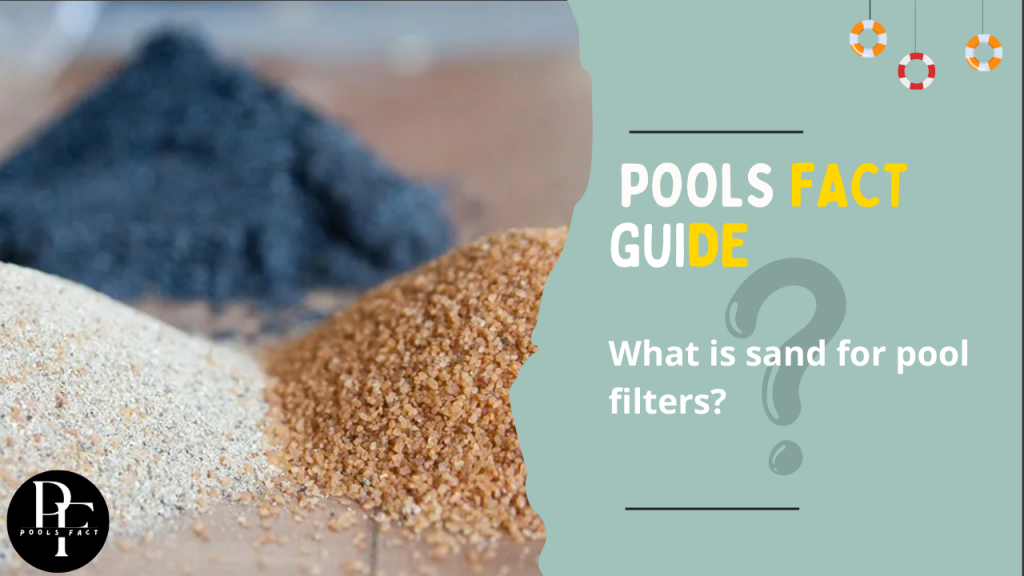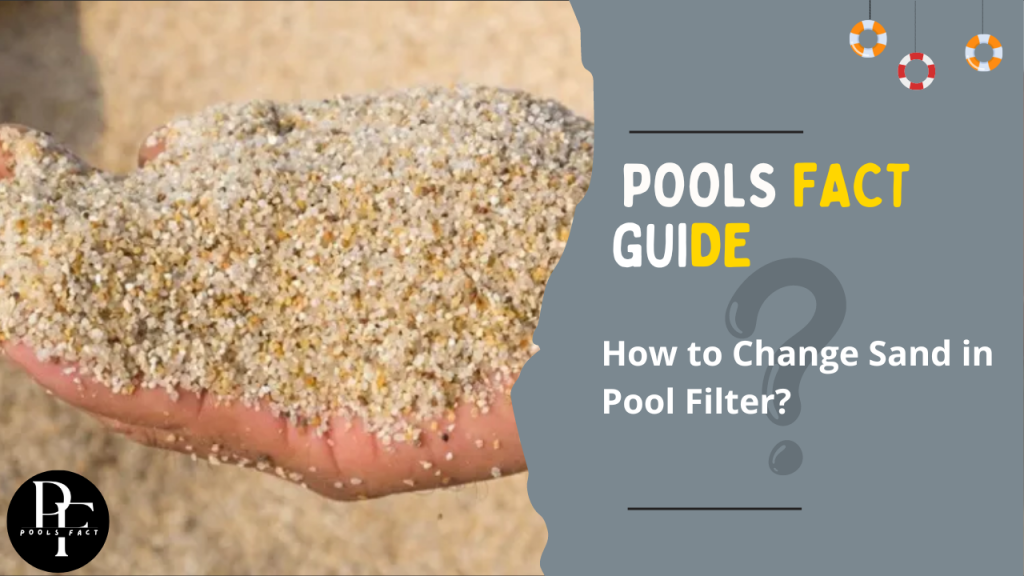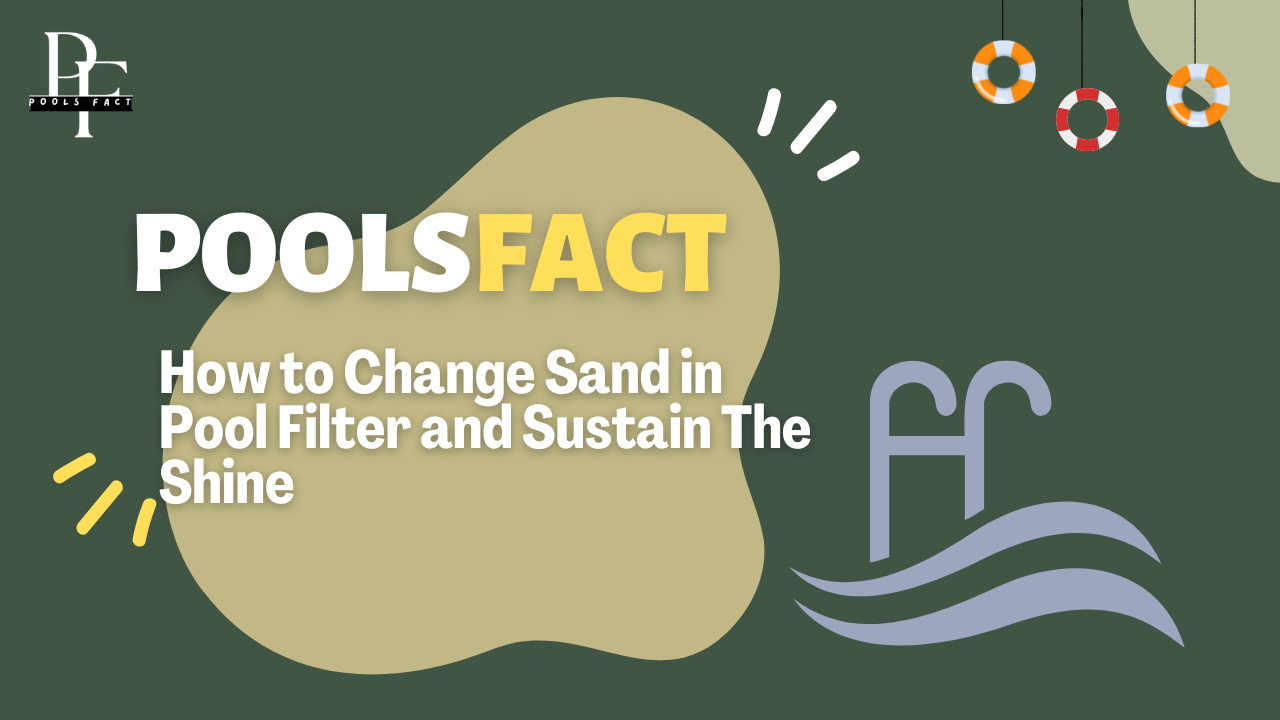Every few years, you should change the sand in your sand pool filter. This is an important part of your swimming pool maintenance routine and a cheap way to keep your pool clean and sparkling every swimming season.
You should be able to perform the relatively straightforward task of replacing the filter sand on your own. Here is a step-by-step guide to the process I use, as well as answers to some of the most common questions I get about changing sand in pool filters.
What is sand for pool filters?
Dead insects Bacteria, algae These are captured by your pool filter so they can’t linger and obscure the water or contaminate swimmers. The substance that catches the impurities is the filter media. In this instance, the medium is sand.

Sand is such a good filter that it is used to clean drinking water, treat sewage, make septic systems, and do other things to keep water safe.
You could assume that all sand is equal since, to the untrained eye, most sand appears to be essentially the same. However, this is not the case. Don’t let the cheap play sandbag in your garage lure you. Your filtration system will be destroyed by it.
Types of Pool Filter Sand
Use one of three types of sand in your pool filter at all times, which is below:
Quartz Sand
This is the sand filter media that is most frequently employed. It is inexpensive and has a long lifespan. This is constructed of ground quartz with a size range of 0.45 to 0.55 mm. The silica sand grains produced by the grinding process have sharp edges, making them the ideal filter media for capturing impurities in your water. Typically, this is referred to as “Premium Filter Sand.”
Crystal Sand
There are two types of glass sand filter media: coarse and fine. The coarse grade of glass sand media, which typically ranges in size from 1.7 to 3.4 mm and makes up 30% of your glass sand filter media needs, is used to cover the under-drain and laterals of your sand filter.
The next step in your setup is to put fine-grade glass sand on top of the coarse-grade glass sand. Although glass sand is more expensive than standard silica sand, it performs far better. It fills up your sand filter with fewer media (by weight), uses less water than backwashing, relieves pressure on your pumps by supplying superior water flow, and lasts a lot longer than regular silica sand.
Zircon Sand
This silica substitute, which is made from volcanic rock minerals called zeolites, has a sponge-like honeycomb form and 100 times more surface area than regular filter sand.
Through a procedure known as molecular sieving, zeolite chemically traps chloramines, the chlorine byproducts that irritate swimmers’ eyes. This is a fancy way of saying that chloramines are stuck inside the zeolite sand particles for good.
If you discover that you need to shock your pool frequently, zeolite sand may help you reduce chlorine without using as many pool chemical additions.
Also Read: What You Should Be Done with Your Pool When It’s Rain?
Why Replace the Sand in Pool Filter?
The filter is where pollutants are caught after being passed through the sand by the pool pump. The pool’s clean water is recirculated. How precisely does the sand trap the gross material while letting clean water flow through?
All three varieties of sand have a rough surface where impurities get stuck when the water runs through, even though it’s much too small to perceive with the human eye.
The rough surface of the sand is gradually removed by the rushing water, leaving a smooth and rounded surface. Under a microscope, the sand from beaches with powerful waves is visibly smoother than that from beaches with gentler waves.
The sand in pool filters, which gets water pumped through it for a number of hours each day, works on the same principle.
Weathering is the process that causes this smoothness. Ironically, the same process that turns sand into dust, which is ineffective for filtering anything, also wears it down to dust.
There are no sharp edges to capture and hold particles in worn pool filter sand. As the filter media nears its end of life, your pool may start to look murky or require more frequent shock treatments.
When to Change Sand in Pool Filter?
Pool filter sand improves with age, but like great wine, it peaks before gradually declining. It has a very brief lifespan of only three to five years. In the sand, toxins accumulate over a period of years.
For the first few years, this actually improves the sand’s capacity to filter water because, in addition to its own jagged edges, the pollutants that are accumulating also serve to filter the water as it goes through the filter.
But ultimately, all that extra junk accumulates to the point where it puts the filter at risk of clogging. At the same time, weathering prevents the sand from absorbing any more pollutants. Your pool’s water quality diminishes when your filter’s effectiveness declines.
When your sand has reached the pinnacle, two additional things could occur. As water passes through clogged-up sand with more difficulty, the pressure might build up inside your filter. The water might then take the path with the least resistance and cut a channel through the sand. This could lower the pressure a little but would make filtration almost impossible.
How Often to Change Sand in Pool Filter?
Pool filter sand can last for years without needing to be changed, depending on usage. We at Poolsfact strongly advise that you replace your filter media sand at least every three years and no later than seven years.
This keeps the stress on your entire pool system to a minimum while also ensuring that your pool water is filtered as effectively as possible. The best way to tell if your sand filter media is getting close to the end of its life is if your pool needs to be shocked more often than usual or if it fogs up more often than usual.
Also Read: Tadpoles In The Pool? How To Get Rid Of Uninvited Guests
Equipment To Replace Sand in Pool Filters
Get your equipment ready for sand change once you’ve confirmed that your filter is the cause of your hazy water. You’ll be astounded at how simple this is.
The Equipment You Will Need:
- A small garden fork
- Buying a vacuum
- A 5-gallon container
- clean filter sand
- Oil-free jelly or silicone paste
- socket set or wrench set
- Screwdriver
- Buying a towel
- patience and time
How to Change Sand in Pool Filter?
The method of changing sand in the pool filter is pretty complicated. The good news is that a sand filter doesn’t usually require new sand for a very long period of time.

Step 1: Obtain the appropriate tools
Before you start the process, be sure you have everything you need. Sand, a spare O-ring between the valve and the tank, Teflon tape, lubrication, and unions can all be found on your list of necessities.
Use only pool filter sand that the manufacturer has authorized. If you’re unsure what kind of sand you need, you can ask at a nearby pool shop.
tip: Your pool filter contains a variety of little but crucial parts. Always put small parts, like the filter drain cap, in a safe place you can remember so you can find them quickly when you need to put the machine back together.
Step 2: Turn off the power.
Turn off the timer and the pool pump (if you have one). Even better, turn off the pump’s electricity at the circuit breaker.
3. Drain the Tank
To release pressure in the filter and drain the water, remove the drain cap located at the bottom of the filter tank. To release all the air, turn the drain cap at the bottom of the tank only a half-turn counterclockwise.
Remove the cover to let the water drain after an air burst. After removing the cap, swiftly connect a hose over the drain to guide the water away from the ground if you don’t want it to drain there.
4. Remove the Multiport Valve
The pump, return, and waste hoses attached to the multiport valve on top of your filter must be disconnected. Remove the multiport valve flange clamp holding the filter in place after those port attachments have been removed. Pull consciously and steadily to remove the valve from the pipe after unscrewing the bolts that connect the clamp.
Simply detach the unions from the multiport valve if your multiport valve has them. You will need to cut the pipes leading to and from your filter if you don’t have unions. It could be a good idea to install unions before reassembling to make maintenance in the future simpler. After the cut, make sure there is enough exposed pipe for both sides of the unions to be added.
Pro tip: To remove the valve from the pipe, gently twist it. The lateral pipes at the bottom of the tank will likely be damaged if you yank too forcefully.
5. Getting Rid of the Old Sand
Tape the pipe end shut as soon as you remove it from the multiport valve to stop sand from getting inside and blocking the laterals. Empty out all of the existing sand after taping off the pipe. Use a plastic cup to scoop it out, and then use a shop vac or vacuum to remove it, until the tops of the laterals at the bottom of the tank are visible.
Step 6: Remove the Pipe and Lateral Assembly
Rotate the 10 lateral pipes slowly upwards, and then gently remove the lateral assembly and pipe from the remaining sand. Look for damage on the laterals, and replace any that are cracked or worn out. After soaking the clogged laterals in a bucket of cleaning solution for a few hours, thoroughly rinsing, and reinserting them into the assembly,
7. Empty the Tank
Wash the tank completely with a garden hose. If you detect any cracks in the drain cap, inspect it and replace it with a new one. To give a cushion and prevent the laterals from being clogged when you add the new sand, fill the filter tank halfway with water.
Also Read: Are You Worried? How To Lower Cyanuric Acid in Pool?
Step 8: Change the Pipe and Lateral Assembly.
With the 10 laterals rotated up, reinstall the lateral assembly and pipe in the tank. Turn all of the laterals 90 degrees back down once the lateral assembly is fixed.
Step 9: Add New Sand
To stop sand from getting inside the pipe and clogging the laterals, tape off the top of the pipe. Pour sand into the filter unit slowly and carefully while maintaining the pipe’s central position in the tank.
Sand should be added until the laterals are entirely covered. To make sure the sand is spread out evenly for good filtration and water flow, level the sand as you pour it.
Advice: Be careful not to raise the lateral assembly and pipe off the tank’s bottom when adding fresh sand. Without rotating the laterals up, you won’t be able to push them back down, and upward-facing laterals will obstruct appropriate filtering.
10. Inspect the O-Ring and possibly replace it.
Take out the O-ring from the multiport valve’s bottom and check it for excessive wear and strain. Even if your O-ring is still in good condition, since you only need to replace it around every five years, it makes sense to do so right away. O-rings are really cheap, but they do eventually wear out.
If you don’t want to replace the O-ring, you can use a silicone-based lubricant sparingly to keep it moving.
Reset the Multiport Control Valve in step 11.
Removing the tape from the pipe’s end will allow you to gently reposition the multiport control valve on the main pipe in its original location. The valve clamps should be fastened tightly around the tank. Reattach the unions to the return ports and the pool pump.
(If your filter doesn’t have unions, use straight couplers to glue the pipes back together.)
Step 12. Backwash the filter.
With the pump still switched off, rotate the valve handle to the “Backwash” setting and then turn on the pump. After it’s fully primed, run the pool pump for about 2 minutes to flush out the impurities in the water and the finer sand particles from the sand media and to ensure that your pool water waste is exiting at the right place.
Once the backwash water runs clear and clean, turn the pool pump off. Switch the multiport valve to “Rinse,” then turn the pump back on. After about a minute, the water in the sight glass should be clear.
Step 13: Have fun!
Turn the pool pump back off and turn the valve to “Filter” (the typical operation mode) (the normal operating mode). Restart the pump, then prepare to enjoy your swim.
Also Read: Nitrates in Pool Water? We’ll Help You to Remove It
Tips
Once everything is operating as it should check the pressure gauge on your valve. The typical pressure for your particular filter is the pressure it is at immediately after. If the pressure is about 10 psi higher than usual, the filter needs to be washed again.
For maximum results, change the sand in your pool filter every five years.
Warnings
Avoid inhaling any dust while adding fresh silica sand to the tank. If inhaled, this silica dust can be harmful. Wear a ventilation mask if you want to be completely safe.
When you change the send in your pool filter, it’s common to have some sand leak out via the waste pipe or back into the pool. You will receive some sand that is smaller than #20, and over time, this smaller sand will find its way through the filter. This will be lessened by the lengthy initial backwash you do when you change the sand in your pool filter.
Additionally, We hope you have enjoyed our guide ” How to Change sand in pool filter”. For more about the pools, stay tuned with us.
Frequently Asked Questions (FAQs)
What Is the Cost of Replacing the Sand in A Pool Filter?
Depending on the size and brand, your sand filter may need 100 to 600 pounds or more of replacement sand, which normally costs roughly $25 per 50-pound bag. For a typical-sized in-ground pool filter, you’ll most likely require 350 pounds of sand.
How Many Bags of Sand Do I Need for A Pool Filter?
You will want 100 pounds (2 x 50 lb bags) of sand for a filter that is 16 inches (41 cm) in diameter. After 16 inches (41 cm), add 25 pounds (half a bag) of sand for every additional inch in the diameter of your filter, up to 20 inches (51 cm).
How Often Should You Backwash a Sand Filter?
How frequently ought I backwash my sand filter? Make sure you apply it if there is an algal bloom or right after a major rain. A DE (diatomaceous earth) filter system must be cleaned at least six times annually. If you have a sand filter, clean it out twice a year and backwash it each month.
What Do You Do with Old Pool Filter Sand?
Strategies for Repurposing Old Pool Filter Sand:
- Squish the sand. Burying the sand on your property is perhaps the simplest approach.
- Use It in Landscape Design. Pool filter sand is an excellent landscaping tool because of its fine texture.
- Use it on your winter sidewalks.
- Engage a Disposal Specialist.
What Happens if You Don’t Change the Sand in Your Pool Filter?
The filter can accumulate dirt and debris over time, and if the sand isn’t replaced, the filter won’t work effectively. Every three to five years, Kara, The Pool Pro, advises replacing the sand in your filter.

Leave a Reply